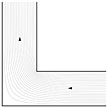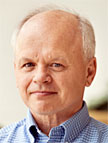- Number 356 |
- February 13, 2012
-
Cutting corners to make superconductors work better
Clem and Berggren calculated the critical current in thin and narrow superconducting strips with sharp right-angle turns, 180-degree turnarounds, and more complicated geometries. They found that current crowding, which occurs at the inner corners when the current rounds sharp turns, significantly reduces the current where a voltage first appears, called the critical current. Rounded corners, according to Clem and Berggren, will significantly improve critical currents. Making superconducting nanocircuits with rounded corners will improve their performance, according to John R. Clem, a physicist at the U.S. Department of Energy’s Ames Laboratory, and Karl K. Berggren, an associate professor of electrical engineering at the Massachusetts Institute of Technology.
Making superconducting nanocircuits with rounded corners will improve their performance, according to John R. Clem, a physicist at the U.S. Department of Energy’s Ames Laboratory, and Karl K. Berggren, an associate professor of electrical engineering at the Massachusetts Institute of Technology.
-
Pioneering microscopic nuclear fuel examination
New nuclear fuel designs have the potential to last longer and bolster safety margins. Nano-scale examination helps researchers understand how fuels perform under prolonged irradiation, but such information has been difficult to obtain. Until now.
Researchers at DOE's Idaho National Laboratory have cleared a hurdle to examining irradiated fuel using a transmission electron microscope. This accomplishment has revealed behavior that suggests increased stability of a new type of reactor fuel. Further study and improvement in nuclear fuel performance are now much more attainable. -
A "natural" solution for transportation
As the United States transitions away from a primarily petroleum-based transportation industry, a number of different alternative fuel sources-ethanol, biodiesel, electricity and hydrogen-have each shown their own promise. Hoping to expand the pool even further, researchers at DOE's Argonne National Laboratory have begun to investigate adding one more contender to the list of possible energy sources for light-duty cars and trucks: compressed natural gas (CNG).
Compressed natural gas is composed primarily of methane, which when compressed occupies less than one percent of the volume it occupies at standard pressure. CNG is typically stored in cylindrical tanks that would be carried onboard the vehicles it fuels. -
Scientists build GPU cluster for subatomic calculations
The latest addition to computing power at DOE’s Fermi National Accelerator Laboratory is a 45-teraflop cluster of graphics processing units that scientists use to explore the properties of the strong nuclear force. The GPU nodes power through data faster than any other computing nodes at more than five times the rate of the processing units of the previous generation.
The cluster is part of a national project called USQCD. Quantum chromodynamics, or QCD, is the theory that explains the properties and behavior of quarks and gluons. Scientists compute the particles’ subatomic interaction, the strong nuclear force, using algorithms and techniques known as lattice QCD. The USQCD collaboration develops the software and hardware needed to meet the high demands of lattice QCD calculations, which require tens of thousands of processors.





